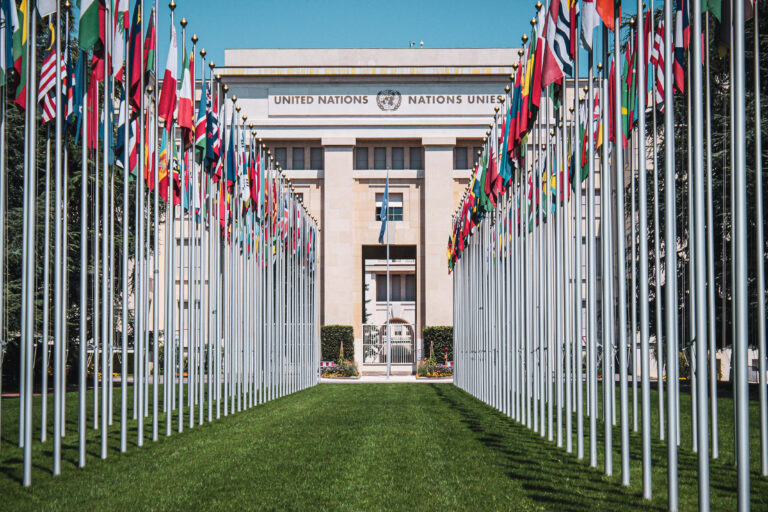Promoting population control through religion
The Institute for Development Training (IDT) attempts to bend religious principle to the promotion of population control through “educational” materials. Among the financial contributors to these efforts are Population Action International; United Board for Christian Higher Education in Asia; Frank Weeden Foundation; David and Lucile Packard Foundation; General Board of Global Ministries of the United Methodist Church; Global Mission Ministry Unit of the Presbyterian Church (USA); and the National Council of Churches, N.Y.
Activities: IDT produced a video titled, “Population and People of Faith: It’s About Time” to be shown at churches and college campuses; IDT staff and volunteers collected signatures for a population/environment declaration which was delivered to U.S. President Bush by the UNFPA-funded Population Institute; IDT population control materials are distributed by “The Center for African Family Studies” (CAFS), an affiliate of IPPF, the Ethiopian Ministry of Health, AMREF/Uganda, and Zimbabwe Association of Christian Hospitals (Institute Development Training Newsletter, December 92).
GNRH hormone in male contraceptive usage
“Gonadotropin releasing hormone (GnRH) is necessary to induce the pituitary to produce follicle stimulating (FSH) and luteinizing hormone (LH). Antagonists to GnRH were developed to prevent spermatogenesis. GnRH antagonists compete with the normal binding sites for GnRH and therefore prevent its elaboration. When 5mg of the antagonist Nal-Glu was given daily to normal men for three weeks, FSH, LH, and testosterone decreased and were totally suppressed from day 18 until the end of the study at 26 weeks. Higher doses of Nal-Glu (10 mg) inhibited the brief escape (paradoxical rise seen in the first week of the study). Because testosterone secretion is necessary for the libido, exogenous testosterone was injected. The study shows that prolonged administration of Nal-Glu antagonists can effectively suppress pituitary and gonadal function, and that the addition of testosterone can result in sustained and reversible azoospermia in men without loss of libido.” [“It remains to be seen what other untoward metabolic effects will turn up if they are looked for,” Ed., Contraception] S.N. Pavlou, “GNRH Antagonists in Men: Development of a Male Contraceptive,” Contraception 46:197, August 1992.
Human papillomavirus (HPV) linked to penile cancer
A study presented at the annual meeting of the American Urological Association, held in Washington, D.C., suggests that HPV-l 6 and HPV-18 may cause up to one-third of all U.S. penile cancers.
The lead investigator, John S. Wiener of Duke University Medical Center in Durham, N.C., said that, “HPV is associated with penile cancer…[this] is the strongest data yet to prove that association.” Dr. Weiner and his colleagues discovered DNA characteristic of HPV-16 in eight of the 29 samples (28 percent) from men with cancer of the penis who had been treated at Duke and other national medical institutions between 1970 and 1991. One man of the 29 had DNA from HPV-18 in his tumor.
Another research team led by Stephen K. Tyring, a virologist at the University of Texas Medical Branch at Galveston, examined the primary tumor and lymph node tissue taken from one man infected with HPV-16 whose cancer had spread to the lymph nodes. They discovered that the “viral DNA had inserted itself into the man’s DNA.” Further, the viral DNA had been “incorporated at the same location in both the primary tumor and the lymph nodes.” Those findings suggest “the viral DNA probably makes changes in the patient’s DNA that may lead to cancer, according to Tyring” (Science News, Vol. 141).
India critiques World Bank Global Environment Facility (GEF)
Indian critics say donors use the World Bank-administered Global Environment Facility (GEF) to push the environmental concerns of the rich nations. Indian NGO’s believe the GEF’s “decision-making” should be changed from the World Bank’s “one dollar, one vote” to the U.N. system of “‘one country, one vote.”
The $1.3 billion GEF was set up in 1990 to help developing nations address problems of “greenhouse gas emissions,” and to protect “plant and animal species from extinction.” About 30 percent of the funds was set aside to “tackle pollution” in international waters including inter-state rivers and to “phase out substances” which “damage ozone in the atmosphere.”
“The objectives, structure and implementation mechanism” of the GEF is not perceived by Indian ecologists as addressing the “needs and concerns” of “environmental security” from the “developing country perspective.”
The U.N. Environment Program (UNEP) estimates 117 poor countries will require $8.55 billion annually for biodiversity protection. GEF has already spent about $700 million — more than 80 percent of this on global warming and biodiversity schemes (IPS, New Delhi, 02/18, “North Dictates How to spend funds for environment…”).
U.N. ECO/SOC Council elects Commission on Sustainable Development
The United Nations’ Economic and Social Council (ECO/SOC) elected 53 members to serve on the Commission on Sustainable Development (CSD). The Commission is charged with overseeing a global environment and development plan. Thirteen members were elected from Africa, 13 from Western Europe, 11 from Asia, 10 from Latin America and six from Eastern Europe.
The resolution adopted by ECO/SOC and the U.N. General Assembly says the commission will monitor implementation of “Agenda 21.” It will also engage in activities related to the integration of environmental and developmental goals throughout the U.N. system. The commission is expected to monitor countries’ progress towards achieving “the U.N. target of 0.7 percent of gross national product (GNP) in Official Development Assistance (ODA).” The Group of 77 developing countries is lobbying for the presidency of the commission. Ambassador Luis Fernando Jaramillo of Colombia told a session of the ECOSOC, “The Group of 77 manifests its wish that the Presidency of the Commission on Sustainable Development be assigned to one of its members” (IPS, 02/17, “U.N. forms commission to oversee new global .… “)
AIDS is projected to affect 1 billion
Speaking to the annual meeting of the American Association for the Advancement of Science, William Haseltine of the Dana-Farber Cancer Institute in Boston said he is convinced that HIV, the virus that causes AIDS, is so prevalent and so resilient that “it will be a serious problem for the indefinite future,” at least for several generations.
He warned against a plan to appoint a U.S. “AIDS Czar”, “Too many basic questions are unknown for an overall commander to begin assigning tasks,” he said.
On a global scale, Haseltine said, HIV is spreading rapidly in the Third World and has reached more than 20 percent of the general adult population in many areas, including Central Africa, India, Thailand, Indonesia and parts of South America. At that rate of increase, he reported that there could be 1 billion cases worldwide (Christopher B. Daly, “Generations will suffer AIDS, scientist asserts disease projected to affect l billion by 2025,” Boston, 12 Feb., Wash. Post).
Johns Hopkins University (JHU) claims developing world has succumbed to birth control propaganda
Birth control use in developing countries is rising rapidly according to Johns Hopkins University School of Public Health. They claim that, “a reproductive revolution is under way in…the developing world.”
“Family planning is no longer a taboo subject,” according to JHU surveys of more than 300,000 women in 44 Asian, African and Latin American countries taken since 1985.” They say an average of 38 per cent of married women in developing countries outside China, or about 238 million, use family planning methods, compared with 70 per cent in the developed world and China. With an additional $2.4 billion, JHU claims “all current family planning needs could be satisfied” (Reuter, 02/28, “Contraception rising in developing world, surveys say”). U.S. congressional members who raised population funding to $340 million in 1992, hope to help by increasing U.S. population funding to $725 million (Family Planning World, Mar/Ap 6).
AIDS international in developing countries
In Zimbabwe, 70 percent of the officer corps of the armed forces are HIV-positive, as are 70 percent of the police in Harare, the capital. In Zambia, two-thirds of the managers of the copper industry are HIV-positive, and this industry supplies 80 percent of the country’s foreign-exchange earnings. In Uganda, 30 percent of all district health officials have or died of AIDS. These people are responsible not only for the response to AIDS, but other health problems as well. One hundred thousand people are being exposed to HIV each day in the brothels of Bombay. In most sub-Saharan African countries, infection rates range from 10 to 20 percent in the general population, and are often over 30 percent in the adult population. This pattern is seen as repeating itself in Asia, Oceania, Latin America and the Caribbean health care needs (International Dateline, Population Communications International, Feb. 1993).
WHO research programs
The World Health Organization (WHO) is developing research programs in human reproduction in Bangladesh, Benin, Bolivia, Ethiopia, Guatemala, Mozambique, Mongolia, Myanmar, Nepal, Sudan, Uganda, Viet Nam, and Zambia.
Ethiopia: In 1990, WHO awarded the Dept. of Ob/Gyn at the University of Addis Ababa a ‘Long-term Institutional Development Grant.’ WHO and the Ministry of Health have proposed the establishment of a National Center for Reproductive Health which will have both service and training components. The World Bank may also fund this center in the future.
Guatemala: In 1992, WHO awarded the Guatemalan Research Group in Reproductive Health a grant to develop a research unit to conduct epidemiological and health service studies.
Myanmar: WHO assisted the Ministry of Health (MOH) in generating research protocols “in priority” areas and approved an MOH “five year institutional development proposal.”
Kenya: WHO’s long term relationship with government has led to the establishment of the National Center for Research in Reproduction in Nairobi. The Dept. of Ob/Gyn assisted in trials of Depo-Provera and Norplant among Kenyan women. The Dept. also promoted the “easy availability of contraceptive drugs” and population propaganda programs among the people (Progress in Human Reproduction, no. 24,1992).
IPPF (Western Hemisphere) pending projects
Legal advice on constitutional and reproductive rights in Barranquilla, and Bucaramga, Colombia; expansion of “family planning” services in the Caribbean; adolescent sex education projects in Brazil, Colombia, Costa Rica and Peru; expansion of model clinic in Turrialba, Costa Rica; integration of family planning, infant mortality and anti-parasite programs in Paraguay; sterilization funding in Jamaica; sex education in Chiapas and Sinoloa; sustain Inter-American Parliamentarian Group which promotes “family planning” through parliament; integrated primary health programs in Chocó and Caquetá; training of public school teachers in family planning in Querertaro, Mexico; expansion of “Medical Railroad Car” to deliver “family planning” in rural Bolivia (Reaching Out, vol.7, Spring 1993, IPPF (WH).










